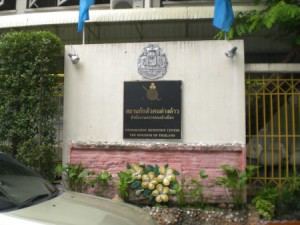Visit to Bangkok’s Immigrant Detention Center

Although Thailand is not the final destination for North Korean defectors flowing into this country, this flow is currently the largest in the world, outside of China. The numbers have steadily increased over the past several years. According to the Thai government, about 1,000 North Korean defectors were detained here in 2007. From 2008 and after, the Thai government stopped publicly announcing numbers, but my estimation is about 1,500 in 2008 and a bit higher in 2009.
One recent group of North Korean defectors , who reached Thailand at the end of January 2010, were detained by police in Northern Thailand and then sent to Immigration Detention Center (IDC) in Bangkok.
In this group was one person with a family member who had previously escaped from North Korea and had now settled in a third country (not named for security reasons). That earlier escapee contacted LFNKR and asked us to help this group now being held in Thailand. So I, together with LFNKR member Ms. Shirahama, visited the IDC in early February where we chatted for two hours with the group. Here is what we found out during the visit.
As of February 2010, about 40 male and 130 female North Koreans were being detained. This meant that the male area had plenty of room, while the female area was quite crowded. This ratio of males to females is a good indicator of the ratio of male and female North Korean defectors entering Thailand.Number of North Korean Defectors Detained at IDC
It was also clear that conditions at the IDC had dramatically improved since 2007-2008. Back then, the number of North Korean defectors constantly exceeded capacity. This often caused problems. For example, inmates could not stretch out full length to sleep because of the extremely limited space. At that time, “spaces” were being unofficially bought and sold. Also, there were only one or two toilets and showers for all the detainees, whose numbers varied and could occasionally approach two hundred. Naturally, this induced severe mental and physical stress.
On this visit, the problems caused by the former overcrowding no longer seemed to exist, judging from what these defectors told us.
Daily Life of the Detainees
The detainees get three meals a day. The meal cost per day per person is about 45 Baht (about US $1.35). This is very cheap even for Thailand, and may not be nutritionally adequate. In addition, the tap water in Thailand is not potable, but the IDC’s tight budget does not seem to include drinkable water. This means that detainees must buy their own drinking water.
With such conditions, kiosks in the IDC play an important role. As long as the detainees have cash, they are allowed to do shopping twice a week. In fact, we were surprised to hear that they can buy almost anything, even including Korean kimchi. They can also buy telephone cards to make international calls if they wish and use them at the pay phones installed in limited-access area.
Legal Processing for Transfer to Third Countries
In Thailand, North Korean defectors wishing to go to their destination third countries are temporarily detained by the Thai police, prosecuted for their illegal entry and charged a fine for the crime (this is more or less a formality), then sent to the IDC in Bangkok where they are held until release. Then they are free to travel to their destinations for resettlement.
As mentioned above, although more defectors were held in temporary detention by the IDC in 2009, the former overcrowding has been significantly reduced. This is mainly because the legal procedures for transferring detainees to their chosen destination have been significantly improved.
About 95% of the North Korean defectors flowing into Thailand elect to go to South Korea. To be able to release them to a third country, there must be mutual agreement first between the Thai government and the government of the destination country, and then among the IDC, the Thai Ministry of Foreign Affairs, and the Thai National Security Advisory Board.
Apparently, the procedures for sending them from the IDC to South Korea are now well established and have become routine, assuring that everything flows smoothly. Currently, about 20 to 30 defectors are being transferred to South Korea every week. On the other hand, the IDC has not yet worked the kinks out of its procedures for sending North Korean detainees to any country other than South Korea. Thus, the procedures where other destination countries are involved are still very time consuming.
At the end of February, the Thai government officially announced its candidacy for election to membership on the UN Commission on Human Rights, planned for May. Clearly, Thailand is deeply involved in the North Korean human rights issue. Citizens of this country have been abducted by North Korea. And of course, great numbers of North Korean defectors continue pouring into Thailand.
We are happy to see that Thailand has expressed an interest in joining the UN Commission on Human Rights. It is vital that NGOs support Thailand’s intent, while also continuing to urge the Thai government to step up efforts to improve conditions related to the North Korean human rights issue. This includes the fact that the Thai government has not yet officially recognized the refugee status of North Korean escapees.





